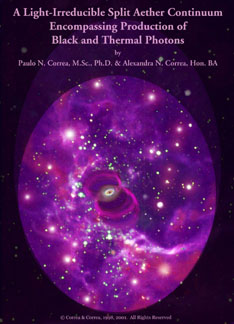![Akronos logo]](/images/akronos_wheel.jpg)
|
Akronos Publishing Concord, ON, Canada www.aetherometry.com |
![Akronos logo]](/images/akronos_wheel.jpg)
|
Akronos Publishing Concord, ON, Canada www.aetherometry.com |

A light-irreducible split-aether continuum encompassing production
of black (HFOT) and thermal (LFOT) photons
by Correa, Paulo N. & Correa, Alexandra N.
Published in November 2001. 36 pages.
Experimental Aetherometry, Vol. 2A
Monograph AS2-11
Price: US $25 ($20 ISFA)
This monograph is also included in the print edition of Experimental Aetherometry, Vol. 2A
|
ABSTRACT
From Descartes' Plenum of subtle matter defined by its luminous character, through Spinoza 's Light and its effects of Colour and Shadow, to the classical electromagnetic theory of a luminiferous aether and modern ZPE theories, the problem of the Aether has always been posed as inseparable from that of Light, the action and transmission of Light. This often entailed a direct reduction of the concept of the aether to that of Light - as is the case with Spinoza -or to that of the electromagnetic field - as is the case with ZPE theories. The situation with Descartes is different, as with Maxwell and Lorentz, because here an implicit division is made between the Aether as support system and Light as either a corpuscular or an undulatory event. It was this concept of an aether as a support of Light which SR made superfluous, 'liberating' Light in the form of an electromagnetic field of constant speed for all inertial mass, and converting all Matter into opaque forms of Light. Thereby, however, Light retained its primacy in physics and natural philosophy. One can contemplate GR as an attempt to eliminate this lingering primacy of Light in SR, by making Light heavy and thus subject to conditioning by the gravitational field, with the result that the gravitational aether becomes a geometric structure where the null intervals of Minkowski Spacetime become the curved geodesics of GR's Spacetime. But making Light heavy is only a way of either attributing the Dark (fuscum subnigrum) to Matter (as was done with the missing mass) or reducing it to a geometry of Light. The only philosopher to seize the Dark as the matrix from which Light and Colour emerge, was Leibniz. His approach to the problem of the vacuum ("there is no vacuum") and his contention in First Truths that neither Space nor Time are things but multiplicities of a continuum that cannot be divided into points, intimate that the fundamental property of a Plenum is not Light but Darkness. The Aetherometric Theory of Synchronicity (AToS) takes up Leibniz 's contention that the aether is not Light but the Dark, which alone explains how Light emerges when the Dark interacts with Matter to confer motion to it. We review Reich 's orgonometric theory of Light, and in particular his concept of an underlying aether excitation wave. Reich 's theory is seen as a precursor to the aetherometric concepts of Light and the Dark. AToS suggests that Light is only a secondary pathway whereby energy returns back to the Dark. The Light spectrum is subdivided into discontinuous (ionizing) and epicontinuous (blackbody) portions, because only the latter results from the interaction of Matter with the Dark, while discontinuous Light results from the disintegration of Matter. But the Dark itself is not homogenous, being split in kind between life-beneficial energy (OR)and life-inimical energy (DOR). AToS holds that the Dark understood in this way designates the electrically ambipolar massfree radiation that serves as one of the major components of the Aether. It is this radiation which, through secondary superimposition, condenses massbound charges, and interacts with the latter to confer to them electrokinetic energy that, once shed, gives rise to blackbody photons which return the energy back to the medium. The nature of the underlying Dark continuum, and its very split in kind, becomes thereby reflected in the biochemical and biophysical nature of blackbody Light, which AToS splits into HFOT (high frequency optothermal - true blacklight) photons and LFOT (low frequency optothermal) photons. HFOT Light is indicative of an underlying DOR action just as LFOT Light is a sign of OR activity. It is the epicontinuous spectrum of Light that betrays the structure of the actual continuum of the electric aether. If the problem of Light is not separable from the problem of the aether, of the Dark, the latter, in turn, is not subsidiary to the problem of Light. As demanded by Leibniz, we must think the Dark independently from Light - as much as from Matter, even if it is the Dark that links both Light and Matter and transmits the excitation waves that produce Light. This Dark is in a permanent state of motion; it is a subtle imponderable energy that carries no mass. One of the major challenges this process of conceptualization poses to AToS is the understanding that the Dark does not just consist of electrically ambipolar massfree radiation. Free electric wave energy forms an electric continuum with definite frequency limits, but this continuum in turn is only a differentiated part of a much greater aether energy continuum formed by nonelectric massfree energy that one may designate as latent - because its 'heat 'is insensible and thus invisible, or because it appears, to modern physics at least, to lack any physical characteristics. The challenge that future presentations will pose is the experimental identification of the physical characteristics of latent aether energy, and of the differentiation process that produces electrically ambipolar massfree energy. |